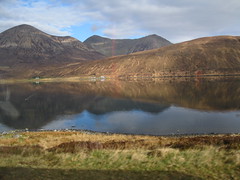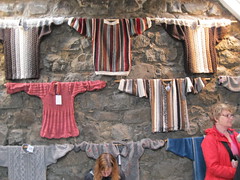Here are a few details about the area:
The name Skye is from the Viking era and means cloud in Norse.
Today, the island has a population of about 10 000 but in the 18th century it was 40 000. About 20% of the islanders speak Gaelic.
The biggest industry, besides tourism is fish farming, usually salmon, which is Scotland's largest food export.
Forests cover 17% of the Isle of Skye.
When Prince Charles visits the area, he is referred to as the Duke of Rothesay, one of his many official titles.
Cape Breton's very own Giant Angus McAskill was born in Dunvegan on Skye.
I swear that this picture was taken one handed from a moving bus. You can even see the bus's shadow along the bottom. It says much about the amazing ability of digital cameras, but also a lot about the beauty of the landscape. And look at that sky! There were many such idyllic moments (and many wetter ones too.)
Our first stop was to The Shalisdair Shop. They're open 7 days a week from 10am-6pm from Easter until the end of October, and during the rest of the year by appointment. I only mention this because of how astonishing it is. A few years ago I arrived at a yarn store on the Upper East Side of Manhattan on a Monday in August to discover that they weren't open on Mondays. Yet The Shalisdair Shop in Waternish, which is a one hour trek through tiny country roads from the bridge that brings one to the Isle, is open 8 hours daily. Bravo for their commitment to their customers, and it was well worth the effort. Somehow the journey only adds to how special it is.
Here is a wall of their gorgeous, one of a kind sweaters which are all for sale, as well as yarn and a wonderful assortment of local crafts and accessories. It was a joy to spend time there. Needless to say, a few purchases were made during the hour we visited.
But the biggest treat of all was meeting Eva, the dye-master. Eva was born in Germany just before the Second World War, grew up in the US, came to Scotland to go to school, and told us that she became only the second landowner in the area who was not born on the Isle of Skye. These days landowners from away outnumber natives.
Eva has been using dyestuff from natural plants, perfecting her techniques over decades, and is renowned across the UK for her expertise. She works in a small workshop with equipment picked up from larger dyeing operations around Scotland as they shut their doors. She explained that red was the most expensive colour to produce as it came from the cochenille beetle, and was consequently used mainly as an accent colour in tartans, or for fancy dress versions.
Eva's operation buys locally spun yarns, the works the magic of the organic colours to create a unique look that reflects the beauty of the country around.
Our next stop was just a bit down the road to Skyeskins, a proud family run tanning operation. But as the demo area was quite small and we were chilled, some of us took refuge at the gallery of Ian Williams, an artist who retired 12 years ago from his job as a policeman to the Isle of Skye. The sign in front of Ian's place advertises: GALLERY, ART, CAFE, TOILETS (obviously of varying degrees of importance to those who drive by his home in Waternish.)
The coffee was great, the homemade scones with butter and his wife's jam were sent directly from heaven, but the best part was meeting Ian himself. He looks very relaxed here. I'm not sure how it was possible to get him in such a pose as I remember that he was as busy as "a one-armed paper hanger", making coffee and serving about 25 unexpected guests all by himself during the hour that we were at Skyeskins.
What a great tour of the tanning operation at Skyeskins. It has always been a mystery to me how the shaggy fleece on the back of outdoor sheep could possibly be teased and cleaned to the degree of perfection that we find in finished sheepskins. It's no longer a mystery, but a lot of hard handwork on the part of a whole series of skilled and knowledgeable people.
Here we see a hide drying "on tenterhooks" after being "stretched to the limit", these expressions having made their way into our modern language.
On to Portree, the population centre of the Isle of Skye (pop. 2 491 according to Wikipedia).
I took a walk through town after lunch and discovered this lovely scene of gorse bushes. I imagine that to the locals it would be like taking a picture of a pile of dandelions but they were so ever present during this trip that I felt it was important to remember the lowly, if prickly bush.
Portree is actually a lovely town with dozens of shops for everything from traditional music to batik clothing, from handmade pottery to haggis. And yes, they even have a lovely store called Over The Rainbow, which among its sweaters and shawls and general merchandise designed to appeal to tourists had a lovely wall of knitting yarn.
And what trip to Scotland would be complete without a picture of a thatched cottage? Actually I was surprised at how few of these cottages there were to be seen. Our bus driver, Ian, pulled over and let us out to get a picture of this beautifully maintained cottage, insisting that we open the gate (that said "private") to go in and get a better picture as there was no car visible on the property. We didn't feel comfortable barging in, despite the fact that apparently there are no laws in Scotland to prevent a person from trespassing. I believe that Marion our guide was relieve.







No comments:
Post a Comment